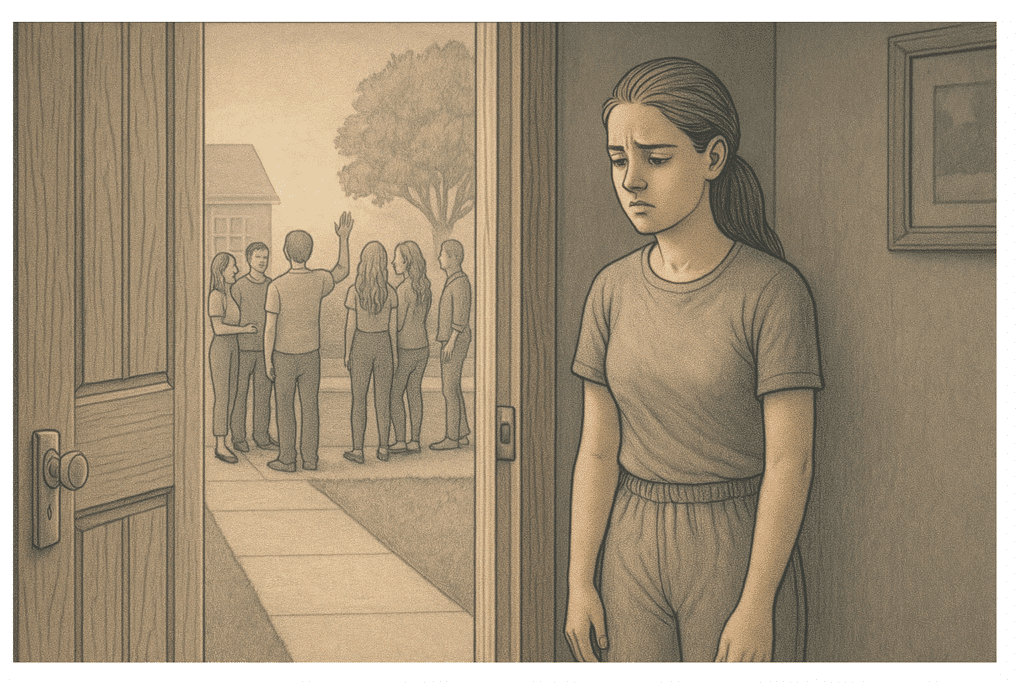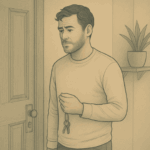Key Takeaways
- Social anxiety is not about shyness, it’s a persistent fear of judgment that can affect identity, relationships, and life choices.
- It shows up in thoughts, physical symptoms, and avoidance behaviors, creating a cycle that reinforces itself over time.
- Research highlights biological roots in brain activity and neurotransmitters, linking social anxiety to broader conversations about neurodivergence.
- The best treatment often blends traditional methods like CBT and medication with affirming approaches that focus on self-acceptance and authentic coping.
- At AMFM, care is compassionate and tailored, combining evidence-based therapies with supportive strategies that help people move beyond anxiety.
The Connection Between Social Anxiety and Neurodivergence
For millions worldwide, social situations can trigger intense fear, self-consciousness, and physical symptoms that disrupt daily life. Known as social anxiety disorder, it affects about 7% of Americans each year. As understanding of brain differences grows, many wonder whether social anxiety fits under the neurodiversity umbrella. The answer isn’t simple, but exploring this link can help people better understand their experiences and access support.
Social anxiety sits in a gray area where medical definitions, lived experiences, and evolving terminology overlap. Psychiatry classifies it as an anxiety disorder, yet many individuals feel they experience the world in ways that relate with neurodivergent perspectives. This tension highlights the evolving conversation around mental health and neurodiversity.
| A Mission For Michael: Expert Mental Health Care Founded in 2010, A Mission For Michael (AMFM) offers specialized mental health care across Southern California, Minnesota, and Virginia. Our accredited facilities provide residential and outpatient programs, utilizing evidence-based therapies such as CBT, DBT, and EMDR. Our dedicated team of licensed professionals ensures every client receives the best care possible, supported by accreditations from The Joint Commission and the California Department of Health Care Services. We are committed to safety and personalized treatment plans. Start your recovery journey with AMFM today! |
What Social Anxiety Really Means
Social anxiety is more than shyness—it’s an intense, persistent fear of being judged or embarrassed in social situations. This fear can lead to avoidance and significantly impact daily life, relationships, and overall well-being.
The condition often begins in adolescence, with about 75% of people with social anxiety developing symptoms before age 15. Early onset can shape social patterns and identity into adulthood. Social anxiety affects all genders and backgrounds, though cultural context can influence how it appears.
Common Symptoms and Experiences
Social anxiety combines psychological and physical responses. Psychologically, it involves intense worry about negative evaluation, making mistakes, or appearing anxious, often well before a social event. Post-event rumination is also common. Physically, it can trigger a racing heart, sweating, trembling, nausea, and difficulty speaking, creating a feedback loop that intensifies anxiety.
Behaviorally, avoidance and “safety behaviors”, over-preparing, speaking quickly, or using coping strategies, can provide temporary relief but often reinforce anxiety over time.
How It Differs From Everyday Nervousness
Normal social nervousness is temporary and doesn’t significantly interfere with life. Social anxiety disorder, however, causes persistent fear that can start weeks before an event and continues afterward. It can affect major life decisions, like career choices or educational opportunities, in ways that typical nervousness does not.

For many, social anxiety begins in childhood, shaping how they experience social cues and rejection sensitivity.
The Brain Science Behind Social Anxiety
Research shows that the amygdala, which processes fear, is overactive in social anxiety, while prefrontal regions that regulate emotions are underactive. Differences in serotonin, dopamine, and GABA systems further influence how social information is processed. These findings suggest social anxiety has neurobiological roots, linking it in some ways to conditions considered neurodivergent.
Understanding Neurodivergence
Neurodivergence refers to variations in the brain affecting sociability, learning, attention, mood, and other functions that differ from what’s considered neurotypical. Emerging from the neurodiversity movement, it frames these differences not as disorders to be cured but as natural variations in human neurology, deserving recognition and respect.
This approach contrasts with traditional medical models that pathologize differences. Conditions like autism or ADHD are seen as involving both challenges and potential strengths. Support focuses on helping individuals thrive while honoring their cognitive styles.
The Evolution of Neurodiversity
The term “neurodiversity” was coined by Australian sociologist Judy Singer in the 1990s, initially relating to autism. Over time, the concept expanded to include ADHD, bipolar disorder, certain anxiety disorders, and learning differences. The movement has influenced research, education, workplace policies, and cultural attitudes, promoting acceptance and reducing stigma while balancing support for challenges.
Recognized Neurodivergent Conditions
Commonly recognized neurodivergent conditions include:
- Autism spectrum disorder (ASD): Differences in social communication, sensory processing, and behavior patterns.
- ADHD: Variations in attention regulation, executive functioning, and impulse control.
- Learning differences: Dyslexia, dyscalculia, dyspraxia.
- Others: Tourette’s syndrome, developmental coordination disorder, synesthesia, some forms of epilepsy.
These classifications continue to evolve as understanding of neurological differences grows.
How Neurodivergence Changes Brain Function
Neurodivergent conditions involve structural and functional brain differences, affecting how information is processed, prioritized, and responded to. For example:
- Autism often shows strong local connectivity but weaker long-distance connectivity, leading to focused attention but integration challenges.
- ADHD involves differences in networks regulating attention and executive function.
These neurological patterns create distinctive cognitive styles and perceptual experiences, supporting the view of neurodivergence as natural variation rather than purely a disorder.
The Ongoing Debate: Is Social Anxiety Neurodivergent?
The question of whether social anxiety is neurodivergent lies between science and identity. Unlike autism or ADHD, its classification is less clear. How it’s defined shapes how people view themselves, seek support, and approach treatment. If neurodivergence includes brain-based differences that shape experience, social anxiety might qualify. But if it refers only to early-onset conditions affecting multiple domains, the case is weaker.
Arguments Supporting Social Anxiety as Neurodivergent
Research shows that those with social anxiety disorder have hyperactivity in the amygdala and changes in brain circuits tied to social fear. Many experience the world with heightened sensitivity to cues and rejection, often from childhood, suggesting neurological traits rather than learned responses. Social anxiety also overlaps with other neurodivergent conditions, hinting at shared brain patterns. For some, the experience feels like a different way of processing, not just stronger fear.
Arguments Against This Classification
Skeptics see social anxiety as an amplified version of normal fear, not a different neurotype. Its responsiveness to therapies that shift thought patterns suggests it is more malleable than conditions usually called neurodivergent. From this view, it reflects heightened anxiety rather than a fundamentally distinct brain organization.
What Mental Health Professionals Say
Experts remain divided. Psychiatry typically classifies social anxiety as an anxiety disorder, grouping it with related conditions. Still, some clinicians recognize subtle neurological differences and adjust treatment, especially when it co-occurs with neurodivergence. This suggests a more nuanced reality than strict categories allow.
What The Neurodivergent Community Says
Among neurodivergent advocates, opinions differ. Some include social anxiety, seeing common struggles in facing social worlds. Others worry that broadening the term weakens its meaning. Many emphasize lived experience, stressing that whatever the label, people with social anxiety need recognition, support, and accommodations.
When Social Anxiety and Recognized Neurodivergence Overlap
Social anxiety often occurs alongside established neurodivergent conditions, creating a complex, bidirectional relationship. Rates are much higher among people with autism and ADHD than in the general population, suggesting shared neurological vulnerabilities. For many, social anxiety is part of a broader pattern of neurological differences that shape how they experience the world.
Social Anxiety in Autism
Among autistic individuals, social anxiety affects 15–50%, compared to about 7% in the general population. This anxiety often stems from difficulty predicting social expectations, processing complex cues, and managing sensory overload. Concerns about masking traits or breaking social rules can intensify anxiety, making the experience neurologically distinct from social anxiety in neurotypical individuals.
Social Anxiety in ADHD
For people with ADHD, social anxiety affects upwards of 49.5%. It often develops from repeated social challenges, like interrupting or missing cues, leading to fears of being “too much” or saying something impulsive. These experiences highlight the interplay between neurodevelopmental differences and social anxiety.
Comorbidity vs. Core Features
The high overlap raises questions about whether social anxiety is a separate condition or a feature of neurodivergence. Some research suggests it can reflect the psychological impact of facing social environments not designed for different neurotypes. This perspective can guide treatment by addressing underlying neurological traits alongside anxiety.
Ultimately, diagnostic boundaries are often arbitrary. Many people display traits across multiple categories, so the focus should be on understanding their unique neurological makeup, strengths, and challenges rather than strictly labeling social anxiety as neurodivergent or not.
How This Classification Affects Treatment Approaches

Comprehensive options like mindfulness, art therapy, or equine therapy can complement evidence-based care.
Whether social anxiety is seen as neurodivergent or as a traditional anxiety disorder shapes treatment in important ways. The medical model often highlights CBT, exposure therapy, and, at times, medication. These aim to reduce symptoms, challenge anxious thoughts, and build confidence in social settings. For many, these methods bring lasting relief.
A neurodiversity lens, however, broadens the picture. Instead of pushing to “fix” anxiety, it emphasizes authentic coping strategies, strengths, and supportive environments. The focus is on empowerment rather than conformity, helping individuals engage with the world in ways that feel sustainable.
Traditional Anxiety Treatment Methods
CBT is considered the gold standard, using thought restructuring and gradual exposure to build practical skills. Research shows 60–75% benefit from this approach. Medication, often SSRIs, sometimes short-term benzodiazepines, can help regulate fear responses and make therapy more effective. These methods work best when anxiety stems from negative experiences, though outcomes are mixed when social anxiety overlaps with autism or ADHD.
Neurodivergent-Affirming Approaches
Therapies tailored for neurodivergence shift the focus from masking to acceptance. They may include sensory regulation, structured social skills, or executive function support. Such approaches also address anxiety tied to stigma, validating the challenges of facing neurotypical environments while encouraging authentic connection.
Finding What Works for You
The most effective treatment often blends both perspectives, using CBT and exposure to reduce fears while also incorporating affirming practices that honour individual needs. Self-advocacy is key, ensuring therapy adapts to each person’s strengths and challenges. Ultimately, treatment is about reducing distress while supporting identity, not fitting into a single model.
Care That Matches the Mind: How AMFM Helps
At A Mission for Michael (AMFM), we understand that social anxiety and the broader challenges that often come with it can feel overwhelming. That’s why our approach is centered on both evidence-based care and genuine compassion. With a 2:1 staff-to-client ratio, we ensure every individual receives the personalized support they deserve.

Supportive environments and community connections play a powerful role in reducing anxiety in daily life.
Our programs are designed to meet people where they are. Whether through residential treatment, partial hospitalization (PHP), intensive outpatient (IOP), or virtual care, we provide different levels of support so recovery feels accessible and sustainable. We draw on therapies such as CBT, DBT, EMDR, animal-assisted therapy, art therapy, and mindfulness-based practices, creating a treatment plan that balances clinical depth with holistic healing.
What sets us apart is our belief that healing goes beyond reducing symptoms. We focus on helping people build authentic coping strategies, develop stronger connections, and feel empowered in who they are. With treatment settings in California, Virginia, Minnesota, and Washington state, our spaces feel comfortable, safe, and designed to support real growth.
Frequently Asked Questions (FAQs)
Can social anxiety develop later in life, or is it present from childhood?
Social anxiety often begins in adolescence, though it can emerge later due to stressful experiences or transitions. Some who develop it later report lifelong social differences, with anxiety intensifying only during more demanding environments or life stages.
How do I know if my social anxiety is severe enough to seek help?
Seek help when anxiety limits education, work, relationships, or enjoyment of activities. Significant avoidance, distress, or physical symptoms that disrupt daily functioning are also indicators. Early support is beneficial, even before anxiety feels overwhelming.
Are there specific accommodations for social anxiety in school or workplace settings?
Yes. Helpful accommodations include advance notice for presentations, flexible participation, breaks during demanding tasks, or written communication alternatives. Workplaces may also adjust meeting requirements. Supports should be tailored individually, with many institutions offering reasonable adjustments regardless of formal classification.
How do I explain my social anxiety to others who don’t understand it?
Use clear examples of how anxiety impacts daily life and compare it to being in a foreign country where mistakes feel constant. Highlight both mental and physical symptoms, while sharing only what feels comfortable for you.
Can medication help with social anxiety if it’s considered neurodivergent?
Yes. Medication, such as SSRIs or short-term benzodiazepines, can ease symptoms regardless of classification. However, many find that therapy and supportive accommodations offer deeper, longer-lasting benefits by addressing underlying thought patterns and coping strategies. Programs like those at AMFM emphasize therapeutic approaches that go beyond symptom relief, helping individuals build resilience, self-understanding, and sustainable ways of managing social anxiety.












